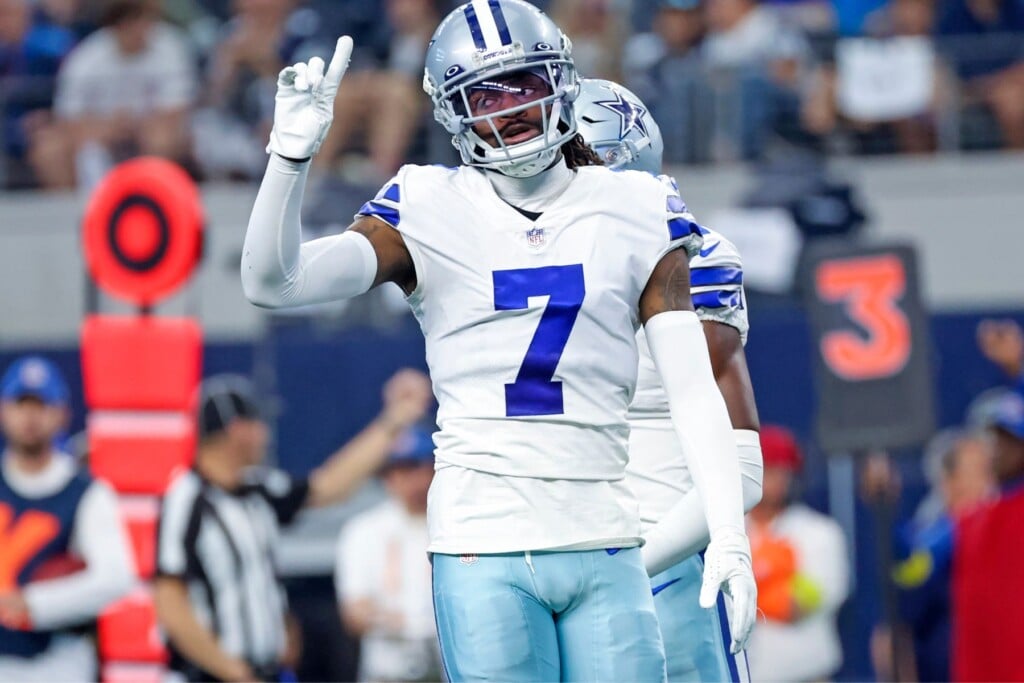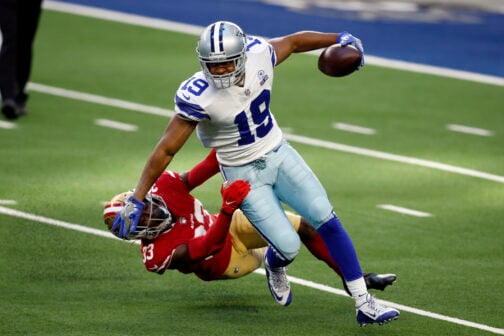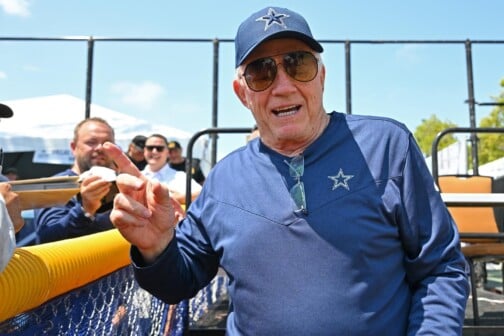Outside of Dak Prescott, no current Cowboy is debated more heavily than cornerback Trevon Diggs. He’s either a true shutdown corner who stands next to Micah Parsons as the focal point of the Cowboys’ elite defense, or he’s a liability who lucked his way into 11 interceptions in 2021. You can see that debate play out every month or so on social media, when Cowboys Twitter puts on its armor and deploys to war with NFL Twitter in defense of the 24-year-old’s honor. These debates are fun; this is what fandom is about. (Well, I think they’re fun. Diggs doesn’t.) But this is no parlor game for the Cowboys’ front office. With Diggs entering the final year of his rookie contract, Dallas must decide what he is—and what that pays. And that is very hard to do.
Defensive back might be the toughest position in the sport to isolate and evaluate. With an edge rusher like Parsons, we can look at statistics like pressure rate or pass rush win rate, and we can watch him rag doll a tackle tasked with blocking him. With running backs, we can look at forced missed tackles or yards after contact in an attempt to separate individual performance and production from the quality of blocking. But when it comes to the secondary, and specifically cornerbacks, things aren’t so straightforward. So much of pass coverage depends on other factors: the demands of defensive schemes, the pass rush (or lack thereof), the skill of other players in coverage.
Outlets like the aforementioned Pro Football Focus do try, though, and this is where we get the dissonance between highlights and “grades.” In Diggs’ 11-interception season, for instance, his coverage grade ranked just 44th out of 99 qualified corners (minimum 50 targets in coverage). The reason for this discrepancy is pretty simple: Diggs was average to flat-out bad in basically every other metric. His 18.5 yards per reception yielded on targets was the worst mark in the NFL by a wide margin. His yards per coverage snap ranked third highest, as did his nine penalties in coverage. He was targeted the seventh-most times in coverage.
The logic was that Diggs plays a boom-or-bust style, gambling for game-changing picks, which left him vulnerable to big plays. That might sounds reductive, but the data back it up. Per PFF, Diggs gave up five catches, all for huge gains, on the five times he was targeted with double-move routes in 2021. Was the trade-off worth it? Probably, yes. True ballhawks, like the one Diggs seemed to be, are few and far between. And for the first time since Deion Sanders, Dallas appeared to have one.
The key word is “appeared.” Diggs started his college career at Alabama as a wide receiver, and there is no doubt he has exceptional ball skills. There is no minimizing that part of his game. But he also had zero dropped interceptions in 2021, and that isn’t going to happen very often. Last year, for instance, he picked off four passes and dropped two more interceptions. Had Diggs converted all six chances last year but went, say, eight for 11 in 2021, the conversation around him would probably be different. The idea of Trevon Diggs as a field-flipping monster isn’t inaccurate, but we are talking about a small sample size driving the narrative.
The good news is that most of Diggs’ other metrics improved in 2022. His coverage grade ranked 35th out of 87 qualified cornerbacks last year, and his yards given up per snap was middle of the pack. They were certainly not elite numbers, however. The top two corners in yards-per-coverage snaps are two players widely regarded as two of the best in the game: Sauce Gardner of the Jets and Patrick Surtain II of the Broncos. So these metrics do tend to smile upon the best to do it. Diggs just doesn’t show up near the top of any of these leaderboards.
Add it up, and you can imagine a world in which the Cowboys get a little squeamish paying top-end money to a cornerback whose prodigious ball skills have yet to drive top-end play. On the other hand, what’s the Cowboys’ alternative? Stephon Gilmore, good as he is, is likely a rental. DaRon Bland was impressive as a rookie but is best used as a slot corner. Ditto Jourdan Lewis, who is also entering free agency. Then there are the off-field benefits. Diggs sells a lot of jerseys, and he’s featured in a lot of highlights. Those things will always matter to the Jones family.
What does Dallas do? Green Bay’s Jaire Alexander, another player who ranks highly in all of the statistics that Diggs doesn’t, became the NFL’s highest-paid corner a year ago when he signed a four-year, $84 million extension. A franchise tag for Diggs in 2024 would be in the neighborhood of $20 million, then possibly $24 million in 2025. Further complicating matters: both Parsons and wide receiver CeeDee Lamb are sure to demand top-of-the-market money when their times come, too. Parsons isn’t just a lock to get it; he will become the highest-paid defensive player in the history of the sport. Lamb might not quite be in the highest tier of his position yet, but he’s currently closer than Diggs.
It’s nearly impossible to imagine the Joneses letting a player like Diggs walk. But there’s really no other way to say it: to this point, Trevon Diggs is not yet a great player.
The Cowboys’ best play, then, is to wait and see. There’s virtually no downside to seeing how he performs this year and reacting accordingly. If he elevates himself to becoming a true shutdown corner on a per-play basis, then pay him. Win-win. If he doesn’t, franchise him, find some contingency plans to develop behind him, and re-evaluate where things stand in the ’24-’25 offseason.
Working in Diggs’ favor is the fact that the Cowboys are truly in a “win now” window. Diggs and his agent know that Dallas and the Jones family are desperate to win a Super Bowl, and their franchise quarterback is about to turn 30. If Diggs balks at an offer of less than $20 million a year, and the Cowboys opt against using the tag, what does the team do?
I think they have to embrace that uncertainty, uncomfortable as it might be. Don’t forget how Diggs got here. He was the heir apparent to Byron Jones, the former first-round pick whom Dallas let walk in free agency when Jones wanted to be one of the highest-paid players at the position. Jones certainly didn’t produce Diggs’ highlights or gaudy interception totals, but a case could be made that he was just as effective as a player during his time in Dallas—good, not great. Dallas went on just fine without Jones because it is one of the NFL’s best drafting teams. If push comes to shove, they probably can do the same without Diggs.
Nevertheless, this will definitely test the front office in all the ways that worry me. Paying for style over substance has long been an area this organization struggles with (see: Elliott, Ezekiel), and no matter how much or little Diggs improves his game this year, you can bet he’ll deliver his usual array of highlight moments. If he leaves, the team will catch flak they never did with Jones, whose lack of forced turnovers made for an easy scapegoat. So their path of least resistance is to pay Diggs either way. The onus is on the cornerback to make sure that would be Dallas’ best path, too.
Get the ItList Newsletter
Author




